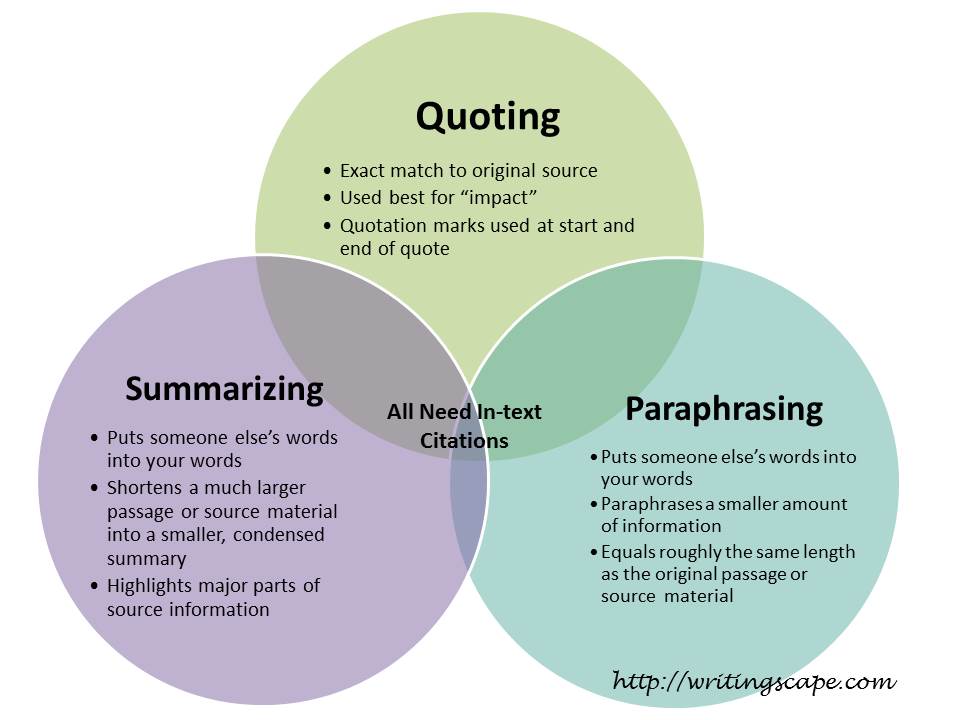The Differences between Quoting, Summarizing, and Paraphrasing
Research plays a huge part in any writing project because this is how you can present information and strengthen your own arguments. As you complete research, you will want to keep track of any sources you examine and be sure to give credit to sources that you do use. There are three main ways of using outside information: quoting, paraphrasing, and summarizing.

Quoting
A direct quotation is one of the most common methods of integrating sources into your work. In a direct quote, you are presenting information from the source material word-for-word. It is best to use this method when you have a specific passage from the source that makes an impact or gives a strong opinion you can focus on.
All direct quotes need quotation marks around them. In addition, they need in-text citations at the end. The formatting of the in-text citation after the direct quote may vary depending on the formatting style you are using. Here are some examples:
APA Formatted Direct Quote:
According to APA: The Easy Way, “Always provide appropriate credit; otherwise, it is considered plagiarism” (Houghton, 2009, p.9).
MLA Formatted Direct Quote:
According to APA: The Easy Way, “Always provide appropriate credit; otherwise, it is considered plagiarism” (Houghton 9).
Summarizing
APA Formatted Direct Quote:
APA: The Easy Way provides an overview of all aspects related to APA formatting. In Part One, the authors provide guidance on how to utilize the features of Microsoft Word for formatting, how to format levels of headings, in-text citations, tables, and avoiding plagiarism (Houghton, 2009).
MLA Formatted Direct Quote:
APA: The Easy Way provides an overview of all aspects related to APA formatting. In Part One, the authors provide guidance on how to utilize the features of Microsoft Word for formatting, how to format levels of headings, in-text citations, tables, and avoiding plagiarism (Houghton).
Paraphrasing
APA Formatted Direct Quote:
(Houghton, 2009).
MLA Formatted Direct Quote:
According to APA: The Easy Way, “Always provide appropriate credit; otherwise, it is considered plagiarism” (Houghton).
References
Houghton, P., & Houghton, T. (2009). APA: the easy way!. Flint, Mich.: Baker College. – in APA formatting
Lorenzen, Gretchen, and Shawn Lorenzen. MLA Easy Formatting Style Writing And Grammar Guide. CreateSpace Independent Publishing Platform, 2012. – in MLA formatting
May I have permission to use this with freshman college composition students? Full attribution – including links to your blog – would be included.
Absolutely! Thanks for asking!
What is the difference between the paraphrasing and the direct quote?
Paraphrasing and direct quotes are two distinct ways of incorporating someone else’s words or ideas into your writing. A direct quote involves using the exact words spoken or written by the original author, while paraphrasing involves restating the author’s ideas in your own words.
Using a direct quote can be helpful when you want to highlight a particularly important or well-phrased point made by the author. It’s also a useful way to provide evidence for a claim or argument that you’re making in your own writing. When using a direct quote, it’s important to place it within quotation marks and provide a citation to indicate the source of the quote.
Paraphrasing, on the other hand, involves rephrasing the author’s ideas in your own words. This can be useful when you want to summarize a larger piece of text or when you need to explain an idea in a way that is clearer or more concise than the original author’s wording. When paraphrasing, it’s important to ensure that you’re accurately representing the author’s ideas, and that you’re not simply copying and pasting their words with a few small changes.
In summary, the key difference between paraphrasing and direct quotes is that direct quotes involve using the exact words of the original author, while paraphrasing involves restating the author’s ideas in your own words. Both techniques can be useful in different contexts, and it’s important to use them appropriately and ethically by providing proper citations and avoiding plagiarism.